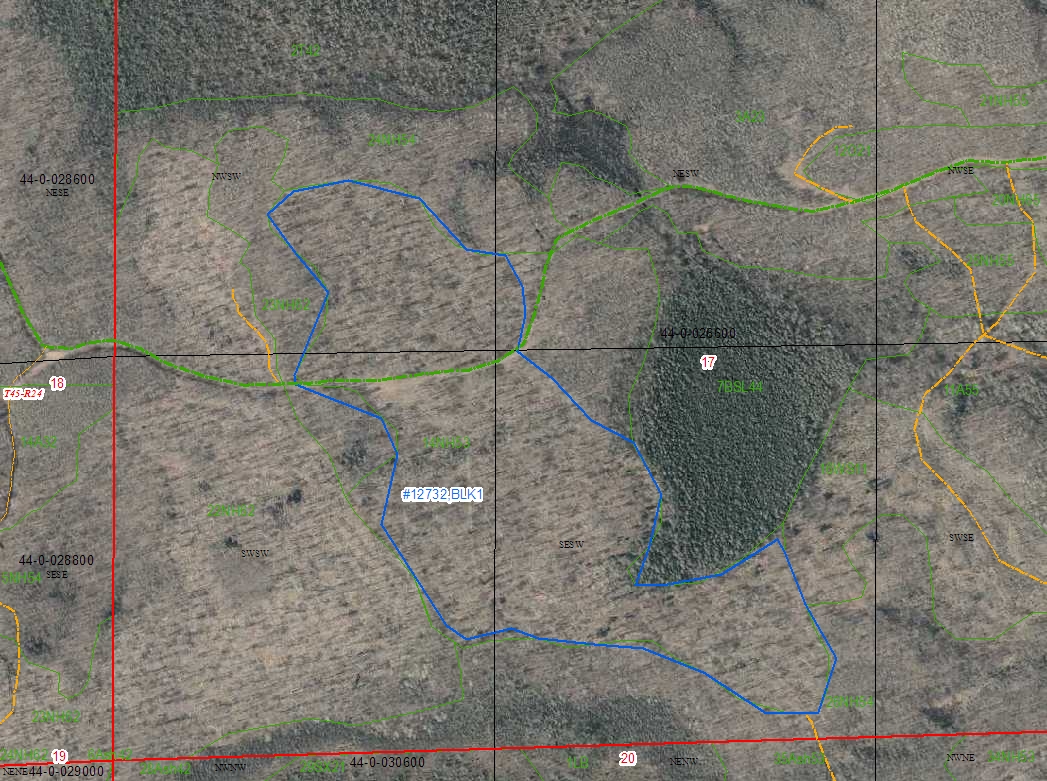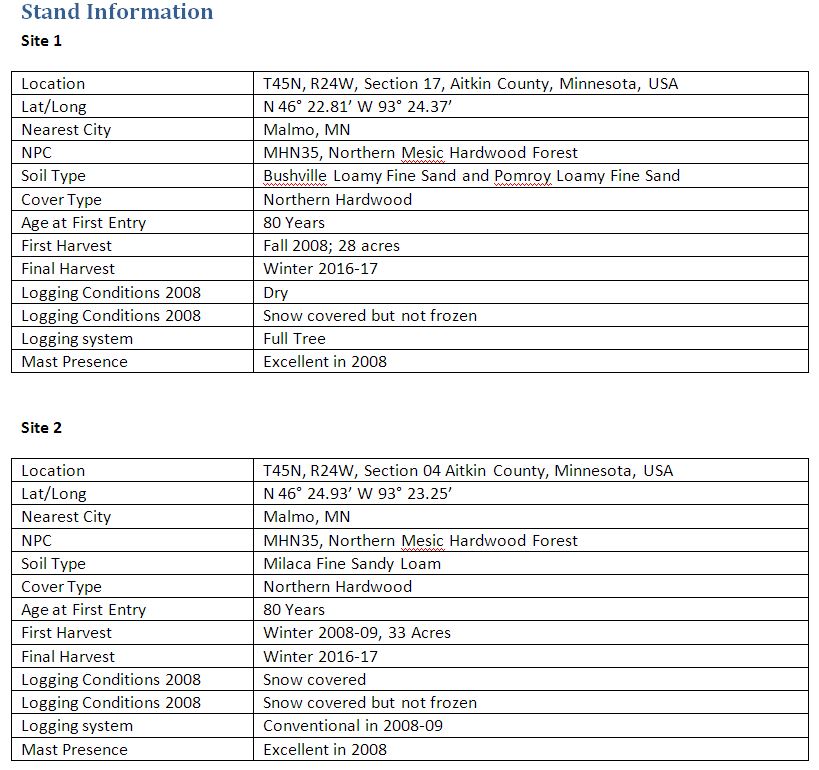Overview
Compare two northern hardwood shelterwood harvests that were logged the same year but with different variables:
- Fall harvest vs. winter harvest
- Loamy Fine Sand vs. Fine Sandy Loam
Silviculture Objective(s)
Take two northern hardwood stand dominated by maple and birch and convert them to an oak, birch and basswood stand through a two step shelterwood system.
Pre-treatment stand description and condition
Pre-treatment growth and stocking:

Figure 1: Aerial photo of site 1.

Figure 2: Aerial photo of site 2.
| Site 1, loamy fine sand | Site 2, fine sandy loam | |
| Initial BA --> Final BA | Initial BA --> Final BA | |
| Acer sp. | 59 --> 12 | 38 --> 5 |
| Quercus rubra | 17 --> 12 | 22 --> 17 |
| Betula papyrifera | 12 --> 4 | 31 --> 13 |
| Tilia americana | 6 --> 5 | 12 --> 6 |
| Populus sp. | 2 --> 0 | 5 --> 0 |
| Fraxinus nigra | 2 --> 2 | 1 --> 1 |
| Betula allaghaniensis | 5 --> 5 | 0 --> 0 |
| Total Basal Area | 103 --> 40 | 109 --> 42 |
Silviculture Prescription
Harvest the forest stand, retaining between 35-49 sq. ft. of residual basal area. This strategy is used to regenerate the stand to mid-tolerant and somewhat intolerant species such as oak, basswood, paper birch and yellow birch under a uniform shelterwood system. Trees are selected for retention during the establishment (first) harvest to retain the best quality, biggest diameter, and preferred species (e.g. oak, birch, and basswood).
Regeneration will then be released by overstory removal when it reaches the desired size and stocking. This effectively converts the stand to a more desirable forest type comprised of the species reserved from harvest. Retention of snags, den trees and the multiple canopy layers should enhance wildlife habitat. Applying BMPs protects water resources potentially impacted by harvest operations.
What actually happened during the treatment
Site 1 (loamy fine sand)
|
First Harvest |
Fall 2008 |
|
Final Harvest |
Winter 2016-17 |
|
Logging Conditions 2008 |
Dry, fall harvest |
|
Logging system |
Full Tree |
|
Acorn Crop |
Excellent in 2008 |
Site 2 (fine sandy loam)
|
First Harvest |
Winter 2008-09, 33 Acres |
|
Final Harvest |
Winter 2016-17 |
|
Logging Conditions 2008 |
Snow covered but not frozen |
|
Logging system |
Conventional in 2008-09 |
|
Acorn Crop |
Excellent in 2008 |
Post-treatment assessment
Regeneration sampling: numbers of stems per acre sampled before the overstory removal in 2010 and 2013, and after overstory removal in 2017 including number of stems greater than 3’ in height. Maple was not counted but was present in large numbers.
|
Site 1 1st Harvest -Fall 2008 Loamy Fine Sand |
2010 |
2013 |
2017 |
>3’ |
Avg. Height |
|
Acer sp. |
Not counted |
Not counted |
3,437 |
1,625 |
2’ |
|
Quercus rubra |
1,100 |
1,386 |
2,316 |
1,800 |
3-5’ |
|
Betula sp. |
3,600 |
2,900 |
4,437 |
3,250 |
3-5’ |
|
Tilia americana |
25 |
22 |
875 |
688 |
2-3’ |
|
Fraxinus nigra |
30 |
0 |
0 |
0 |
2-3’ |
|
Total Trees |
4,755 |
4,308 |
11,065 |
7,363 |
|
|
Site 2 1st Harvest -Winter 2008 Fine Sandy Loam |
2010 |
2013 |
2017 |
>3’ |
Avg. Height |
|
Acer sp. |
Not counted |
Not counted |
4,636 |
2,272 |
2-3’ |
|
Quercus rubra |
860 |
2,000 |
772 |
409 |
2-3’ |
|
Betula sp. |
640 |
1,363 |
3,590 |
2,227 |
3-4’ |
|
Tilia americana |
600 |
180 |
909 |
228 |
2-3’ |
|
Fraxinus nigra |
136 |
0 |
590 |
318 |
2’ |
|
Total Trees |
2,236 |
3,543 |
10,497 |
5,454 |
|

Figure 3: Regeneration at site 1.

Figure 4: Regeneration at site 2.

Figure 5: Summary of treatment and stand information.
Summary / lessons learned / additional thoughts
- Both silviculture prescriptions were a success
- Site 1 had better regeneration because of a combination of fall logging and lighter soils.
- In 2017, Oak (Quercus) and birch (Betula) had significant height advantage over maple (Acer). The height difference was more pronounced in Site 1, the loamy fine sand.
- For unknown reasons, height growth of oak and birch were better on Site 1, loamy fine sand.
- Winter harvest can produce adequate oak and birch regeneration given a good acorn and seed crop.
- Shelterwood harvest is an effective method to regenerate oak and birch under a variety of scenarios.
Supplemental content ("appendices")
![]() Download 12732aerial.jpg (544.56 KB)
Download 12732aerial.jpg (544.56 KB)
![]() Download 12722aerial.jpg (538.56 KB)
Download 12722aerial.jpg (538.56 KB)
![]() Download stand_info.jpg (140.35 KB)
Download stand_info.jpg (140.35 KB)
Submitted by
Bob Kangas
Aitkin County, through its Land Department, is responsible for the management of more than 222,000 acres of tax forfeited land. The County has a long tradition of being a sound steward of this resource providing timber and fiber for industry, offering recreational opportunities for residents and visitors, and sustaining the ecological integrity of the land and its forests.

